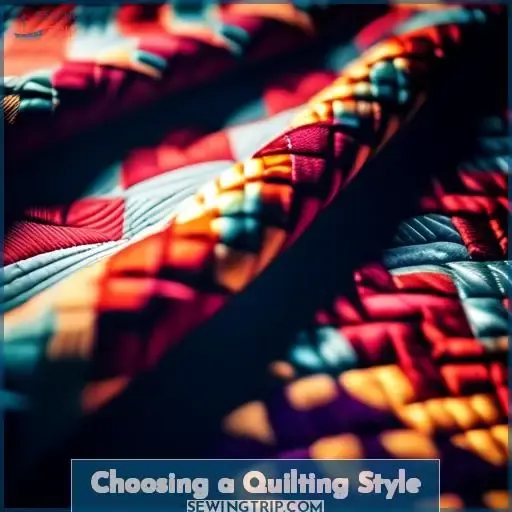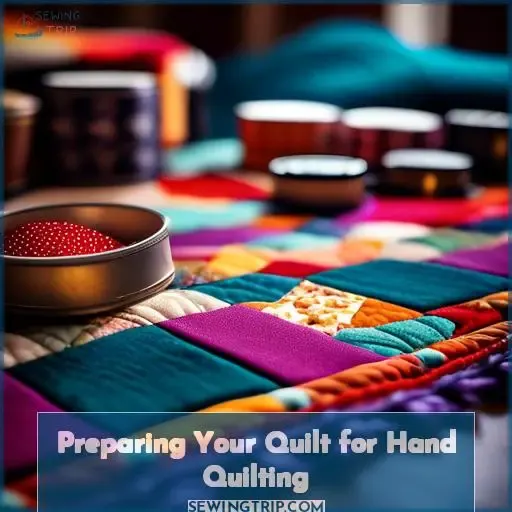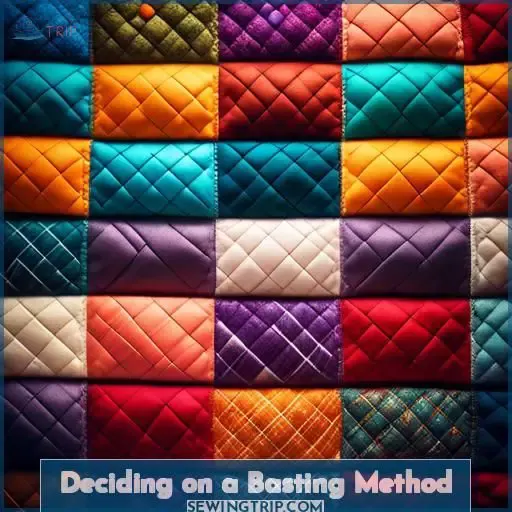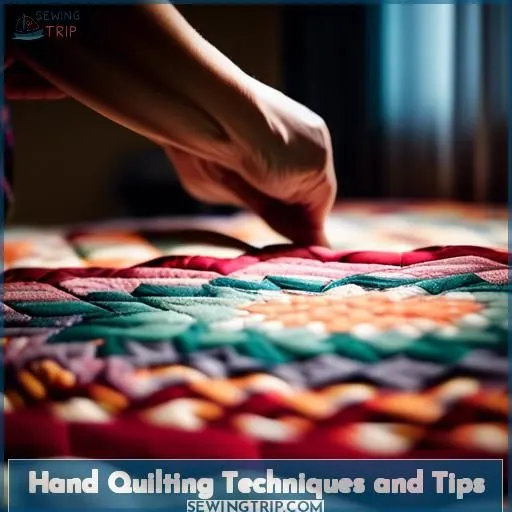This site is supported by our readers. We may earn a commission, at no cost to you, if you purchase through links.
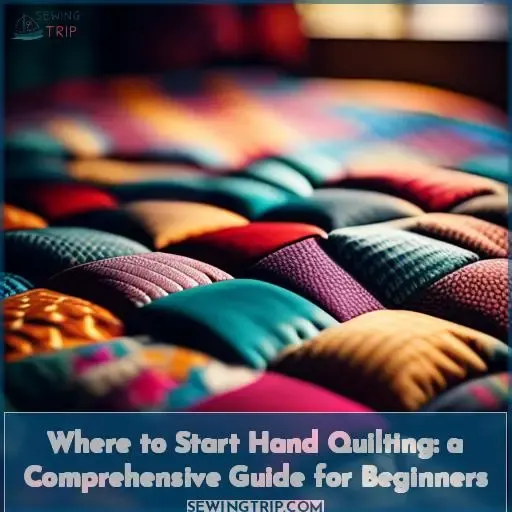
This comprehensive guide takes you step-by-step through where to start hand quilting.
You’ll learn quilting styles, prepping your quilt, selecting needles and thimbles, basting methods, and stitching techniques.
Embrace the joy of creating stunning handmade quilts with this encouraging, informative resource tailored to beginners.
Unleash your creativity and master this timeless craft.
Table Of Contents
Key Takeaways
- Choose a quilting style that suits your preferences and skill level.
- Prepare your quilt fabric by washing, drying, and pressing it properly.
- Select the right needles and thimbles for your quilting project.
- Decide on a basting method that provides a strong hold and is easy to remove after quilting.
Choosing a Quilting Style
Before you start hand quilting, you need to choose a quilting style and decide whether or not to use a hoop. There are many different quilting styles to choose from, so take some time to look at examples and decide which one you like best.
Quilting Styles
Choosing a quilting style is a personal journey that depends on your preferences and skill level.
For beginners, traditional Western stitching with tiny, consistent stitches is a great starting point.
Modern/big stitch quilting, with larger stitches and heavier thread, can add a bold statement.
Traditional Eastern stitching features larger stitches and thicker threads for beautiful designs.
It’s not merely about the stitches; it’s about the journey towards creating a hand-quilted quilt.
Hoop vs. No Hoop
When it comes to hand quilting, the choice between using a hoop or not can be a complex decision.
A hoop provides tension and prevents fabric distortion.
However, it may limit your movement and require ergonomic considerations.
Not using a hoop allows for more fluid movement and the ability to drape the quilt.
However, it may increase the risk of shifting layers.
Consider your project’s portability and personal preference when making your decision.
Starting Points
When it comes to hand quilting, choosing a starting point can be a daunting task. There are several options to consider, each with its own advantages and disadvantages.
- Center Start: Divides the quilt into even sections, reducing puckering and distortion. It requires more planning and measuring, but ensures a symmetrical appearance, suitable for intricate quilting designs.
- Corner Start: Allows for gradual progression, making it easier for beginners. It may result in uneven quilting, but can be used to create specific quilt patterns.
- Baptist Fan: Originates from a corner and fans out evenly across the quilt, creating a decorative effect. It can be challenging to maintain even spacing and is suitable for large quilts.
Preparing Your Quilt for Hand Quilting
Hand quilting is a beautiful and rewarding craft, but it requires careful preparation to ensure a successful and enjoyable experience. In this section, we’ll guide you through the essential steps to prepare your quilt for hand quilting.
Fabric Preparation
- Washing: Decide whether to pre-wash your fabrics or not. If you choose to wash, use a gentle cycle and avoid overloading the machine to prevent fabric distortion.
- Drying: Air-dry your fabrics to prevent shrinkage and wrinkles.
- Pressing: Iron your fabrics on a low heat setting, using a pressing cloth to protect them from the iron.
Quilt Sandwich
Assemble your quilt sandwich by layering your quilt top, batting, and backing. This can be done with thread or spray basting.
Batting Selection
Choose the right batting for your project based on its purpose and your quilting style. Wool is a popular choice for hand quilting due to its softness and ease of use.
Pressing Techniques
Learn proper pressing techniques to ensure accurate cutting and sewing results. Press your fabrics flat and straight to prevent distortion.
Quilt Size
Consider the size of your quilt and choose a batting that suits its dimensions. For larger quilts, stronger batting may be necessary.
Quilt Top, Batting, and Backing
Ensure your quilt top, batting, and backing are clean and free of lint before starting your hand quilting.
Follow a hand quilting tutorial to learn the basics of hand quilting, including threading your needle, inserting the needle, and hiding the knot.
By following these steps, you’ll be well-prepared to embark on your hand quilting journey. Remember, patience and practice are key to mastering this craft. Happy quilting!
Selecting the Right Needles and Thimbles
Choosing the right needles and thimbles is crucial for comfortable and efficient hand quilting. Needles come in various sizes and shapes, while thimbles protect your fingers and provide extra control.
Needle Selection Tips
When it comes to needle selection for hand quilting, there’s a world of options to navigate.
Sharps needles are popular for their fine point.
Straw needles are known for their durability.
Sashiko needles are designed to enhance the thicker threads used in traditional Eastern stitching.
Understanding the complexities of needle types and sizes will help you tailor your needle selection towards your desired quilting style.
It’s not merely about finding the right needle, but also about choosing the needle that best suits your quilting project.
In the realm of hand quilting, needle selection is an ever-evolving process.
It’s advisable to seek more than just the basics.
A suite of quilting needles is designed to enhance your hand quilting experience, whether you’re a beginner or a seasoned quilter.
Thimble Types & Benefits
When it comes to selecting the right thimble for hand quilting, consider various factors like thimble materials, shapes, sizes, durability, and comfort. Thimbles come in different materials such as leather or silicone, offering varying levels of protection and comfort. Ensure to choose a thimble that fits well and provides the necessary support for your hand quilting endeavors.
Thread Weight Considerations
Just like finding the perfect thimble, selecting your thread type is a game-changer. With weight options from delicate 50 wt to bold 12 wt, your stitches can whisper or shout. Color choice? It’s your quilt’s secret spice—blend or pop, it’s all in your hands. Dive into hand quilting resources for a rainbow of inspiration.
Deciding on a Basting Method
Now that you’ve chosen your quilting style and prepared your fabric, it’s time to decide on a basting method. Basting is the process of securing your quilt layers together before you start hand quilting. This step is crucial to ensure your quilt holds its shape and doesn’t shift during the quilting process.
There are two main basting methods: thread and spray basting. Thread basting involves using a long needle and thread to sew through all three layers of your quilt, securing them together. This method is more traditional and can be time-consuming, but it provides a strong hold and is favored by some hand quilters.
On the other hand, spray basting uses a spray adhesive to attach your quilt layers together. This method is quicker and easier, but it can be more challenging to remove the adhesive from your quilt after quilting. It’s also not suitable for quilts with delicate fabrics or embellishments.
When choosing a basting method, consider the thickness of your batting and the length of your stitches. Thicker batting may require a stronger hold, making thread basting a better option. Longer stitches may also benefit from a stronger hold.
In the heart of the hand quilting realm, you’ll find a wealth of knowledge and inspiration. It’s not merely about choosing a basting method; it’s about unlocking the secrets of hand quilting and unveiling the beauty it holds. So, choose your method wisely and let your creativity soar!
Starting Your First Stitch
Embarking on your first hand quilting project can be an exciting and rewarding experience. With the right guidance, you can master the art of hand quilting and create beautiful, unique quilts. In this section, we’ll walk you through the process of starting your first stitch, ensuring you have the necessary knowledge to begin your quilt making journey.
- Knot Placement: Begin by tying a quilter’s knot on the end of your thread, as demonstrated in. This knot will help secure the thread and prevent it from unraveling.
- Hiding the Knot: To hide the knot, weave it between the batting layers, as suggested in. This technique ensures that the knot isn’t visible on the back of your quilt.
- Stitch Angle: Hold the needle at a 90-degree angle to the fabric and insert it through the front of your quilt, about 1/2 to 1 from where you plan to begin stitching. Bring the needle up through all of the layers to the top.
- Starting Point: Choose your starting point based on the quilt design and your personal preference. For example, you might start in the center of a specific block or motif, or you might opt for a corner start, which allows for a gradual progression.
Once you’ve completed these steps, you’re ready to begin stitching. Remember, hand quilting is a slow, meticulous process that requires patience and attention to detail. As you progress, you’ll develop a rhythm and find that the process becomes more enjoyable and satisfying.
In the next section, we’ll explore hand quilting techniques and tips to help you create beautiful, intricate stitches and designs.
Hand Quilting Techniques and Tips
After threading your needle and making that first stitch, you’re ready to dive deeper into the art of hand quilting. Remember, every stitch tells a story, weaving together not just fabric, but the rich tapestry of quilt history.
- Thread Selection: Choose your thread like you’re picking a character for an epic saga. Whether it’s bold and dramatic or subtle and nuanced, your thread sets the tone.
- Needle Protection: Don your thimble like a knight’s armor. Thimble comfort is crucial for those long quilting sessions, protecting your fingertips from becoming battle-worn.
- Basting Options: Think of basting as laying down the tracks for your quilting train. Whether you opt for thread or spray, a solid foundation keeps your project on track.
- Stitch Variation: Don’t be afraid to mix it up. From the precision of traditional stitches to the boldness of modern ones, experimenting with stitch variation adds depth and personality to your quilt.
Embrace these hand quilting techniques and tips as your toolkit for crafting masterpieces. With each stitch, you’re not just quilting; you’re connecting with a tradition that spans generations.
Frequently Asked Questions (FAQs)
What is the difference between traditional and modern hand quilting styles?
Traditional quilting features tiny, consistent stitches for subtle texture. In contrast, modern quilting showcases bold, larger stitches that add personal flair. Explore both styles to find your unique expression.
How do you choose a basting method for hand quilting?
You’ll want to choose a basting method that securely holds your quilt sandwich together while allowing easy removal post-quilting.
What are the benefits of using a hoop while hand quilting?
Like a steady anchor, a hoop keeps your quilt taut — an oasis of control amidst the swirling stitches. Embrace its embrace; it’ll hold your fabric snug, preventing pesky puckers.
How do you start a hand quilting project, such as choosing a quilting design and threading a needle?
Pick your quilt pattern, gather threads and needles. Knot your thread, bring needle up through batting. Rock needle for first stitch – voila, you’ve begun! Stay calm, take your time, and enjoy this intimate craft.
What are some tips for hand quilting, including needle placement and stitching techniques?
Over 50% start by placing the needle perpendicular for clean entries. Use a rocking motion, keeping stitches consistently sized for an even, professional look.
Conclusion
Embarking on the journey of where to start hand quilting opens a captivating vista of creativity. With diligent preparation and perseverance, you’ll soon find yourself stitching breathtaking, handmade quilts. Let this comprehensive guide be your compass as you traverse the rewarding realm of hand quilting, ultimately crafting exquisite heirlooms to cherish for generations.

